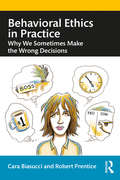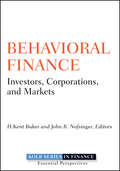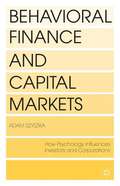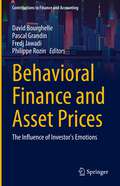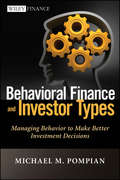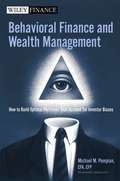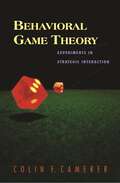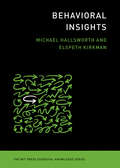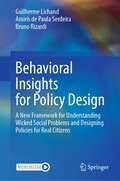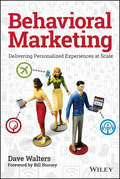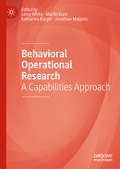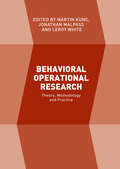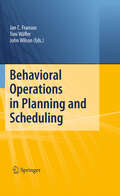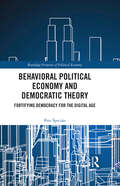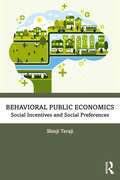- Table View
- List View
Behavioral Ethics in Practice: Why We Sometimes Make the Wrong Decisions
by Cara Biasucci Robert PrenticeThis book is an accessible, research-based introduction to behavioral ethics. Often ethics education is incomplete because it ignores how and why people make moral decisions. But using exciting new research from fields such as behavioural psychology, cognitive science, and evolutionary biology, the study of behavioural ethics uncovers the common reasons why good people often screw up. Scientists have long studied the ways human beings make decisions, but only recently have researchers begun to focus specifically on ethical decision making. Unlike philosophy and religion, which aim to tell people how to think and act about various moral issues, behavioral ethics research reveals the factors that influence how people really make moral decisions. Most people get into ethical trouble for doing obviously wrong things. Aristotle cannot help, but learning about behavioral ethics can. By supplementing traditional approaches to teaching ethics with a clear, detailed, research-based introduction to behavioral ethics, beginners can quickly become familiar with the important elements of this new field. This book includes the bonus of being coordinated with Ethics Unwrapped – a free, online, educational resource featuring award-winning videos and teaching materials on a variety of behavioral ethics (and general ethics) topics. This book is a useful supplement for virtually every ethics course, and important in any course where incorporating practical ethics in an engaging manner is paramount. The content applies to every discipline –business ethics, journalism, medicine, legal ethics, and others – because its chief subject is the nature of moral decision making. The book is also highly relevant to practitioners across all sectors.
Behavioral Finance
by John R. Baker H. Kent NofsingerA definitive guide to the growing field of behavioral finance This reliable resource provides a comprehensive view of behavioral finance and its psychological foundations, as well as its applications to finance. Comprising contributed chapters written by distinguished authors from some of the most influential firms and universities in the world, Behavioral Finance provides a synthesis of the most essential elements of this discipline, including psychological concepts and behavioral biases, the behavioral aspects of asset pricing, asset allocation, and market prices, as well as investor behavior, corporate managerial behavior, and social influences. Uses a structured approach to put behavioral finance in perspective Relies on recent research findings to provide guidance through the maze of theories and concepts Discusses the impact of sub-optimal financial decisions on the efficiency of capital markets, personal wealth, and the performance of corporations Behavioral finance has quickly become part of mainstream finance. If you need to gain a better understanding of this topic, look no further than this book.
Behavioral Finance
by Edwin T. Burton Sunit N. ShahAn in-depth look into the various aspects of behavioral finance Behavioral finance applies systematic analysis to ideas that have long floated around the world of trading and investing. Yet it is important to realize that we are still at a very early stage of research into this discipline and have much to learn. That is why Edwin Burton has written Behavioral Finance: Understanding the Social, Cognitive, and Economic Debates. Engaging and informative, this timely guide contains valuable insights into various issues surrounding behavioral finance. Topics addressed include noise trader theory and models, research into psychological behavior pioneered by Daniel Kahneman and Amos Tversky, and serial correlation patterns in stock price data. Along the way, Burton shares his own views on behavioral finance in order to shed some much-needed light on the subject. Discusses the Efficient Market Hypothesis (EMH) and its history, and presents the background of the emergence of behavioral finance Examines Shleifer's model of noise trading and explores other literature on the topic of noise trading Covers issues associated with anomalies and details serial correlation from the perspective of experts such as DeBondt and Thaler A companion Website contains supplementary material that allows you to learn in a hands-on fashion long after closing the book In order to achieve better investment results, we must first overcome our behavioral finance biases. This book will put you in a better position to do so.
Behavioral Finance And Capital Markets
by Adam SzyszkaBehavioral Finance helps investors understand unusual asset prices and empirical observations originating out of capital markets. At its core, this field of study aids investors in navigating complex psychological trappings in market behavior and making smarter investment decisions. Behavioral Finance and Capital Markets reveals the main foundations underpinning neoclassical capital market and asset pricing theory, as filtered through the lens of behavioral finance. Szyszka presents and classifies many of the dynamic arguments being made in the current literature on the topic through the use of a new, ground-breaking methodology termed: the General Behavioral Asset Pricing Model (GBM). GBM describes how asset prices are influenced by various behavioral heuristics and how these prices deviate from fundamental values due to irrational behavior on the part of investors. The connection between psychological factors responsible for irrational behavior and market pricing anomalies is featured extensively throughout the text. Alternative explanations for various theoretical and empirical market puzzles - such as the 2008 U. S. financial crisis - are also discussed in a convincing and interesting manner. The book also provides interesting insights into behavioral aspects of corporate finance.
Behavioral Finance and Asset Prices: The Influence of Investor's Emotions (Contributions to Finance and Accounting)
by Fredj Jawadi David Bourghelle Philippe Rozin Pascal GrandinIn recent decades, the financial markets have experienced various crises, shocks and disruptive events, driving high levels of volatility. This volatility is too strong to be fully justified simply by changes in fundamentals. This volume discusses these highly relevant issues with special focus on asset pricing and behavioral finance. Financial price assets of the 2020s appear to be driven by various attractors in addition to fundamentals, and there is no doubt that investor emotions, market sentiment, the news, and external factors such as uncertainty all play a key role. This has been clearly observed in recent years, especially during the ongoing coronavirus pandemic that has changed the common perception of the way financial markets work.
Behavioral Finance and Investor Types
by Michael PompianAchieve investing success by understanding your behavior typeThis groundbreaking book shows how to invest wisely by managing your behavior, and not just your money. Step by step, Michael Pompian (a leading authority in the practical application of Behavioral Finance concepts to wealth management) helps you plan a strategy targeted to your personality. The book includes a test for determining your investment type and offers strategies you can put into use when investing. It also includes a brief history of the stock market, and easy-to-comprehend information about stocks and investing to help you lay a solid foundation for your investment decisions.Behavioral Finance and Investor Types is divided into two parts. Test Your Type, gives an overview of Behavioral Finance as well as the elements that come into play when figuring out BIT, like active or passive traits, risk tolerance, and biases. The book includes a quiz to help you discover what category you are in. Plan and Act, contains the traits common to your type; an analysis of the biases associated with your type; and strategies and solutions that compliment and capitalize on your BIT.Offers a practical guide to an investing strategy that fits both your financial situation and your personality typeIncludes a test for determining your tolerance for risk and other traits that will determine your investment typeWritten by the Director of the Private Wealth Practice for Hammond Associates--an investment consulting firm serving institutional and private wealth clientsBehavioral Finance and Investor Types offers investors a better sense of what drives them and what puts on their breaks. By using the information found here, you'll quickly become savvy about the world of investing because you'll come to understand your place in it.
Behavioral Finance and Wealth Management
by Michael M. PompianThe book that applies behavioral finance to the real world Understanding how to use behavioral finance theory in investing is a hot topic these days. Nobel laureate Daniel Kahneman has described financial advising as a prescriptive activity whose main objective should be to guide investors to make decisions that serve their best interests. The reality? That's easier said than done. In the Second Edition of Behavioral Finance and Wealth Management, Michael Pompian takes a practical approach to the growing science of behavioral finance, and puts it to use for real investors. He applies knowledge of 20 of the most prominent individual investor biases into "behaviorally-modified" asset allocation decisions. Offering investors and financial advisors a "self-help" book, Pompian shows how to create investment strategies that leverage the latest cutting edge research into behavioral biases of individual investors. This book: Shows investors and financial advisors how to either moderate or adapt to behavioral biases, in order to improve investment results and identifies "the best practical allocation" for investment portfolios. Using these two sound approaches for guiding investment decision-making, behavioral biases are incorporated into the portfolio management process Uses updated cases studies to show investors and financial advisors how an investor's behavior can be modified to improve investment decision-making Provides useable methods for creating behaviorally modified investment portfolios, which may help investors to reach their long term financial goals Heightens awareness of biases so that financial decisions and resulting economic outcomes are improved Offers advice on managing the effects of each bias in order to improve investment results This Second Edition illustrates investors' behavioral biases in detail and offers financial advisors and their clients practical advice about how to apply the science of behavioral finance to improve overall investment decision making.
Behavioral Finance and Wealth Management
by Michael Pompian"Pompian is handing you the magic book, the one that reveals your behavioral flaws and shows you how to avoid them. The tricks to success are here. Read and do not stop until you are one of very few magicians."--Arnold S. Wood, President and Chief Executive Officer, Martingale Asset ManagementFear and greed drive markets, as well as good and bad investment decision-making. In Behavioral Finance and Wealth Management, financial expert Michael Pompian shows you, whether you're an investor or a financial advisor, how to make better investment decisions by employing behavioral finance research. Pompian takes a practical approach to the science of behavioral finance and puts it to use in the real world. He reveals 20 of the most prominent individual investor biases and helps you properly modify your asset allocation decisions based on the latest research on behavioral anomalies of individual investors.
Behavioral Finance and Your Portfolio: A Navigation Guide for Building Wealth (Wiley Finance)
by Michael M. PompianBecome a more strategic and successful investor by identifying the biases impacting your decision making. In Behavioral Finance and Your Portfolio, acclaimed investment advisor and author Michael M. Pompian delivers an insightful and thorough guide to countering the negative effect of cognitive and behavioral biases on your financial decisions. You’ll learn about the “Big Five” behavioral biases and how they’re reducing your returns and leading to unwanted and unnecessary costs in your portfolio. Designed for investors who are serious about maximizing their gains, in this book you’ll discover how to: ● Take control of your decision-making—even when challenging markets push greed and fear to intolerable levels ● Reflect on how to make investment decisions using data-backed and substantiated information instead of emotion and bias ● Counter deep-seated biases like loss aversion, hindsight and overconfidence with self-awareness and hard facts ● Identify your personal investment psychology profile, which you can use to inform your future financial decision making Behavioral Finance and Your Portfolio was created for individual investors, but will also earn a place in the libraries of financial advisors, planners and portfolio managers who are determined to counteract the less principled and data-driven aspects of their decision making.
Behavioral Finance at JP Morgan
by Aldo Sesia Malcolm P. BakerFollowing a successful model in Europe, JP Morgan has introduced a set of five U.S. retail mutual funds with an investment philosophy and marketing strategy grounded in behavioral finance. The asset management group believes that understanding investor biases like overconfidence, anchoring, and loss aversion is key to generating returns on the investment side and educating clients on the advisory side.
Behavioral Finance for Private Banking: From the Art of Advice to the Science of Advice (Wiley Finance #534)
by Thorsten Hens Kremena K. Bachmann Enrico G. De GiorgiAn essential framework for wealth management using behavioral finance Behavioral Finance for Private Banking provides a complete framework for wealth management tailored to the unique needs of each client. Merging behavioral finance with private banking, this framework helps you gain a greater understanding of your client’s wants, needs, and perspectives to streamline the decision making process. Beginning with the theoretical foundations of investment decision making and behavioral biases, the discussion delves into cultural differences in global business and asset allocation over the life cycle of the investment to help you construct a wealth management strategy catered to each individual’s needs. This new second edition has been updated to include coverage of fintech and neurofinance, an extension of behavioral finance that is beginning to gain traction in the private banking space. Working closely with clients entails deep interpersonal give and take. To be successful, private banking professionals must be as well-versed in behavioral psychology as they are in finance; this intersection is the heart of behavioral finance, and this book provides essential knowledge that can help you better serve your clients’ needs. Understand the internal dialogue at work when investment decisions are made Overcome the most common behavioral biases—and watch for your own Learn how fintech and neurofinance impact all aspects of private banking Set up a structured wealth management process that places the client’s needs front and center Private banking clients demand more than just financial expertise. They want an advisor who truly understands their needs, and can develop and execute the kind of strategy that will help them achieve their goals. Behavioral Finance for Private Banking provides a complete framework alongside insightful discussion to help you become the solution your clients seek.
Behavioral Finance in the Digital Era: Saving and Investment Decisions (Routledge International Studies in Money and Banking)
by Elżbieta Kubińska Magdalena Adamczyk-Kowalczuk Anna MackoDue to swift technological changes and the resultant digital revolution, a wide range of new digital financial products and services have emerged in the financial markets, as witnessed in the context of the fintech sector, the economics of blockchain and NFT issuance. This book takes an in-depth look at the challenges faced by individuals who make investment decisions in a rapidly changing financial world and presents a concise and thorough overview of the multifaceted approach to investment and savings behavior. It explores behavioral digital finance, referencing the latest theories in economic psychology and financial markets and provides an analysis of the process of saving and investing in the context of our new digital reality, where an understanding of human–AI interaction and its benefits and threats is extremely important. It combines an accessible overview of classical and new behavioral theories, models of financial decision making as well as an analysis of the new trends in financial decision making. Special attention is given to financial decision support systems and the role of financial advice services, which are of growing importance, due to their increasing complexity and difficulty. The book combines theoretical considerations and wide-reaching empirical analyses from a representative sample of international respondents. It deals with the individual approach to human risk-taking, and human–AI interaction and its benefits and threats. The book explores how people react to algorithms, what drives algorithm aversion and appreciation, and how understanding of those mechanisms can be employed to improve financial advisory systems and also considers the impact of the Covid-19 pandemic on financial behavior. Chapter 4 of this book is freely available as a downloadable Open Access PDF at www.taylorfrancis.com under a Creative Commons Attribution-Non Commercial-No Derivatives (CC-BY-NC-ND) 4.0 International license.
Behavioral Game Theory: Experiments in Strategic Interaction (The Roundtable Series in Behavioral Economics)
by Colin F. CamererGame theory, the formalized study of strategy, began in the 1940s by asking how emotionless geniuses should play games, but ignored until recently how average people with emotions and limited foresight actually play games. This book marks the first substantial and authoritative effort to close this gap. Colin Camerer, one of the field's leading figures, uses psychological principles and hundreds of experiments to develop mathematical theories of reciprocity, limited strategizing, and learning, which help predict what real people and companies do in strategic situations. Unifying a wealth of information from ongoing studies in strategic behavior, he takes the experimental science of behavioral economics a major step forward. He does so in lucid, friendly prose. Behavioral game theory has three ingredients that come clearly into focus in this book: mathematical theories of how moral obligation and vengeance affect the way people bargain and trust each other; a theory of how limits in the brain constrain the number of steps of "I think he thinks . . ." reasoning people naturally do; and a theory of how people learn from experience to make better strategic decisions. Strategic interactions that can be explained by behavioral game theory include bargaining, games of bluffing as in sports and poker, strikes, how conventions help coordinate a joint activity, price competition and patent races, and building up reputations for trustworthiness or ruthlessness in business or life. While there are many books on standard game theory that address the way ideally rational actors operate, Behavioral Game Theory stands alone in blending experimental evidence and psychology in a mathematical theory of normal strategic behavior. It is must reading for anyone who seeks a more complete understanding of strategic thinking, from professional economists to scholars and students of economics, management studies, psychology, political science, anthropology, and biology.
Behavioral Insights (The MIT Press Essential Knowledge Series)
by Michael Hallsworth Elspeth KirkmanAn accessible introduction to the behavioral insights approach, which applies evidence about human behavior to practical problems.Our behavior is strongly influenced by factors that lie outside our conscious awareness, although we tend to underestimate the power of this "automatic" side of our behavior. As a result, governments make ineffective policies, businesses create bad products, and individuals make unrealistic plans. In contrast, the behavioral insights approach applies evidence about actual human behavior--rather than assumptions about it--to practical problems. This volume in the MIT Press Essential Knowledge series, written by two leading experts in the field, offers an accessible introduction to behavioral insights, describing core features, origins, and practical examples.
Behavioral Insights for Policy Design: A New Framework for Understanding Wicked Social Problems and Designing Policies for Real Citizens
by Guilherme Lichand Amiris de Serdeira Bruno RizardiThis textbook is an introductory guide to applying behavioral sciences and systemic thinking into public policy design and implementation. It presents an innovative public management toolkit to handle ‘wicked’ social problems – those not very responsive to traditional public policy instruments – by incorporating insights from the behavioral sciences and systemic design in the diagnostics of public problems, based on the motivations and constraints of the ‘real citizen’ – beyond the ideal citizen’s perfectly rational intentions and plans devoid of social context or self-control problems. This volume aims to motivate the inclusion of broader and deeper insights from the behavioral sciences – especially behavioral economics, cognitive psychology, and social psychology – to the repertoire of public managers by introducing new methodologies for diagnosing the root causes behind public problems and for designing effective policies to address them. The new diagnosis tool – the MSI framework (an acronym for Motivation, Self-control, and Inattention problems) –, will help identify new mechanisms underlying social problems or reinterpret known problems based on behavioral insights. The new methodology for policy design – the PRIx framework (an acronym for Pricing policies, Regulatory policies, and Information policies) –, will enrich existing policy tools with such behavioral insights. Behavioral Insights for Policy Design: A New Framework for Understanding Wicked Social Problems and Designing Policies for Real Citizens will be a useful and practical guide to public managers and students of graduate and advanced undergraduate courses in public management interested in learning how to apply innovative tools and methodologies inspired by the behavioral sciences into public policy design in a simple and practical way, even when dealing with complex social problems.
Behavioral Insights in Cybersecurity: A Guide to Digital Human Factors (Security, Audit and Leadership Series)
by Dustin S. SachsBehavioral Insights in Cybersecurity: A Guide to Digital Human Factors by Dr. Dustin S. Sachs is a timely and essential resource for cybersecurity professionals, leaders, and organizational strategists seeking to understand the powerful role of human behavior in shaping digital security outcomes. Bridging the gap between behavioral science and cybersecurity, this book challenges the traditional reliance on purely technical defenses and explores why human error accounts for up to 95% of cybersecurity breaches. Drawing from psychology, cognitive science, and organizational behavior, Dr. Sachs provides a compelling framework for rethinking how individuals, teams, and systems interact in high‑stakes digital environments.Through real‑world examples and practical strategies, the book examines how cognitive biases, decision fatigue, stress, and cultural dynamics influence security performance. Leaders will learn to recognize and mitigate biases like availability and confirmation bias, implement structured decision‑making processes, and foster cultures that prioritize security without sacrificing usability or autonomy.This book introduces the “Technology Strategy Needs Pyramid,” a human‑centric model that moves beyond compliance to build mature, resilient, and ethically grounded cybersecurity ecosystems. From designing intuitive interfaces and leveraging behavioral analytics to implementing AI‑driven adaptive defenses and ethical nudging, Dr. Sachs equips readers with actionable tools to align human tendencies with security goals.Whether addressing insider threats, social engineering, or the limitations of legacy awareness training, Behavioral Insights in Cybersecurity advocates for a holistic approach that integrates technology, behavior, and culture. It is a must‑read for cybersecurity leaders seeking to create sustainable, secure environments where people are not the weakest link—but the strongest asset.This book is not just a guide—it’s a call to reimagine cybersecurity leadership through the lens of human behavior, ethics, and strategic decision‑making.
Behavioral Interactions, Markets, and Economic Dynamics: Topics in Behavioral Economics
by Shinsuke Ikeda Hideaki Kiyoshi Kato Fumio Ohtake Yoshiro TsutsuiThis book collects important contributions in behavioral economics and related topics, mainly by Japanese researchers, to provide new perspectives for the future development of economics and behavioral economics. The volume focuses especially on economic studies that examine interactions of multiple agents and/or market phenomena by using behavioral economics models. Reflecting the diverse fields of the editors, the book captures broad influences of behavioral economics on various topics in economics. Those subjects include parental altruism, economic growth and development, the relative and permanent income hypotheses, wealth distribution, asset price bubbles, auctions, search, contracts, personnel management and market efficiency and anomalies in financial markets. The chapter authors have added newly written addenda to the original articles in which they address their own subsequent works, supplementary analyses, detailed information on the underlying data and/or recent literature surveys. This will help readers to further understand recent developments in behavioral economics and related research.
Behavioral Issues in Operations Management: New Trends in Design, Management, and Methodologies
by Ilaria GiannoccaroBehavioral Operations Management has been identified in the last years as one of the most promising emerging fields in Operations Management. Behavioral Issues in Operations Management explains and examines up-to-date research in this field, which works to analyze the impact of human behavior on the management of complex operating systems. A collection of studies from leading scholars presents different methodologies and approaches, supported by real data and case studies. Issues such as building trust and strong cooperative relationships with suppliers, enhancing motivation and designing proper incentives for stimulating more effective decision maker behaviours are considered. The main decision-making processes affected by behavioral issues are also analyzed with a focus on new product development, logistics, and supply chain integration. The broad coverage of methodologies and practical implications makes Behavioral Issues in Operations Management an ideal reference for both researchers developing new topics such as NK fitness landscapes and managers with an interest in behavioral management operations.
Behavioral Marketing: Delivering Personalized Experiences at Scale
by Dave WaltersGrow revenue by leveraging behavioral marketing during your next campaign Behavioral Marketing guides you in using relatively new marketing tactics to grow revenue and create process efficiencies. An incredibly valuable text, this book defines the key principles of behavioral marketing—including customer journey mapping, channel-level planning, data capture and hygiene, campaign creation, delivery best practices, and measurement/optimization—and shows you how to fix highly inefficient processes while implementing your next marketing initiative. Within the pages of this resource are the secrets to improving processes and becoming more 'revenue predictable'—things that benefit businesses in virtually any industry. Additionally, this book provides you with case studies that spotlight the successes and challenges experienced by other marketing pros, and offer up key lessons to assist you in sharing their triumphs and avoiding their pitfalls. Behavioral marketing, a term first coined in 2008, has become increasingly important as digital marketing tactics have becoming increasingly popular. This particular facet of marketing focuses on responding to the actions, clicks, and behaviors of both current and prospective customers—and allows you to use this data to adapt your marketing efforts to customer preferences. The results of this dynamic marketing approach are often a more predictable revenue stream and a more efficient marketing department, both of which any business would welcome! Understand the key principles of behavioral marketing Create a more 'revenue predictable' business environment Examine case studies across multiple industries Discover how to achieve revenue growth and process efficiencies with the right behavioral marketing tactics Behavioral Marketing is a unique resource that brings value and insight to all marketing professionals using digital marketing tactics.
Behavioral Operational Research: A Capabilities Approach
by Martin Kunc Jonathan Malpass Leroy White Katharina BurgerThis edited collection addresses the question of which capabilities and competencies enable Behavioral Operational Research to provide sustained improvement to decision processes. The aim is to show how a focus on capability and competency will not only meet short-term requirements for problem solving and decision support, but also build a solid foundation for the future. The contributors present recent advances in Behavioral OR, with a focus on the ways in which users of models deal with incomplete and imprecise information, subjective boundaries and uncertainty. These chapters are structured around three key dimensions of BOR: capabilities, cognition and aspects of practice.
Behavioral Operational Research: Theory, Methodology And Practice
by Martin Kunc Jonathan Malpass Leroy WhiteBehavioral research is making a significantimpact on many academic disciplines. Its status as the source of some of themost profound research in the social sciences is unparalleled. Therefore, it is not surprisingthatinterest in Behavior and Operational Research (OR) isburgeoning, even though understanding the relationship between knowledge, behaviorand action has been an academic preoccupation in OR since the beginning of thediscipline. This book introduces the idea of Behavioral OR,where the theoretical and empirical developments in the behavioral field aremaking an impression on OR academics and practitioners alike. The book providesa much needed overview that connects together theory, methodology and practiceand offers the "state of the art" on Behavioral Operational Research theory andpractice. The book not only includes chapters by leading academics, but alsoincludes rich and insightful real-life case studies by practitioners.
Behavioral Operations in Planning and Scheduling
by Jan C. Fransoo John R. Wilson Toni WaeflerHuman and organizational factors have a substantial impact on the performance of planning and scheduling processes. Despite widespread and advanced decision support systems, human decision makers are still crucial to improve the operational performance in manufacturing industries. In this text, the state of the art in this area is discussed by experts from a wide variety of engineering and social science disciplines. Moreover, recent results from collaborative studies and a number of field cases are presented. The text is targeted at researchers and graduate students, but is also particularly useful for managers, consultants, and system developers to better understand how human performance can be advanced.
Behavioral Political Economy and Democratic Theory: Fortifying Democracy for the Digital Age (Routledge Frontiers of Political Economy)
by Petr ŠpeciánDrawing on current debates at the frontiers of economics, psychology, and political philosophy, this book explores the challenges that arise for liberal democracies from a confrontation between modern technologies and the bounds of human rationality. With the ongoing transition of democracy’s underlying information economy into the digital space, threats of disinformation and runaway political polarization have been gaining prominence. Employing the economic approach informed by behavioral sciences’ findings, the book’s chief concern is how these challenges can be addressed while preserving a commitment to democratic values and maximizing the epistemic benefits of democratic decision-making. The book has two key strands: it provides a systematic argument for building a behaviorally informed theory of democracy; and explores how scientific knowledge on quirks and bounds of human rationality can inform the design of resilient democratic institutions. Drawing these together, the book explores the centrality of the rationality assumption in the methodological debates surrounding behavioral sciences as exemplified by the dispute between neoclassical and behavioral economics; the role of (ir)rationality in democratic social choice; behaviorally informed paternalism as a response to the challenge of irrationality; and non-paternalistic avenues to increase the resilience of the democratic institutions towards political irrationality This book is invaluable reading for anyone interested in behavioral economics and sciences, political philosophy and the future of democracy.
Behavioral Predictive Modeling in Economics (Studies in Computational Intelligence #897)
by Vladik Kreinovich Songsak Sriboonchitta Woraphon YamakaThis book presents both methodological papers on and examples of applying behavioral predictive models to specific economic problems, with a focus on how to take into account people's behavior when making economic predictions. This is an important issue, since traditional economic models assumed that people make wise economic decisions based on a detailed rational analysis of all the relevant aspects. However, in reality – as Nobel Prize-winning research has shown – people have a limited ability to process information and, as a result, their decisions are not always optimal. Discussing the need for prediction-oriented statistical techniques, since many statistical methods currently used in economics focus more on model fitting and do not always lead to good predictions, the book is a valuable resource for researchers and students interested in the latest results and challenges and for practitioners wanting to learn how to use state-of-the-art techniques.
Behavioral Public Economics: Social Incentives and Social Preferences
by Shinji TerajiBehavioral Public Economics shows how standard public economics can be improved using insights from behavioral economics. Public economics typically lists four market failures that may justify government intervention in markets—imperfect competition (or natural monopoly), externalities, public goods, and asymmetric information. Under the rational choice paradigm (‘agents choose what is best for them’), public economics has examined the welfare effects of policy. Recent research in behavioral economics highlights a fifth market failure—individuals may make mistakes in pursuing their own well-being. This book calls for a rethinking of assumptions of individual behavior and provides a good foundation for public economic theory. Key features: Introduces behavioral perspectives into public economics. Explains why economic incentives often undermine social preferences. Reveals that social incentives matter for public policy. This book will be an invaluable resource for researchers and postgraduate students in public economics, behavioral economics, and public policy.
